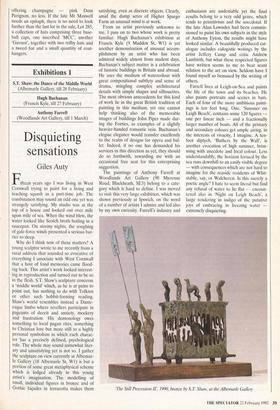Exhibitions 1
Hugh Buchanan (Francis Kyle, till 27 February) Anthony Farrell (Woodlands Art Gallery, till I March)
Disquieting sensations
Giles Auty
Fifteen years ago I was living in West Cornwall trying to paint for a living and teaching squash as a part-time job. The combination may sound an odd one yet was strangely satisfying. My studio was at the top of a house and looked out over mile upon mile of sea. When the wind blew, the water looked like Scotch broth boiling in a saucepan. On stormy nights, the soughing of gale-force winds presented a serious bar- rier to sleep.
Why do I think now of these matters? A Young sculptor wrote to me recently from a rural address that sounded so evocative of everything I associate with West Cornwall that a host of fond memories came flood- ing back. This artist's work looked interest- ing in reproduction and turned out to be so in the flesh. S.T. Shaw's sculpture concerns a 'middle world' which, as he is at pains to point out, has nothing to do with Tolkien or other such hobbit-forming reading. Shaw's world resembles instead a Dante- esque limbo where revellers participate in pageants of deceit and anxiety, mockery and frustration. His demonology owes something to local pagan rites, something to Christian lore but more still to a highly personal symbolism in which each charac- ter has a precisely defined, psychological role. The whole may sound somewhat liter- ary and unsatisfying yet is not so. I gather the sculpture on view currently at Albemar- le Gallery (18 Albemarle St, WI) is but a portion of some great metaphysical scheme which is lodged already in this young artist's imagination. The modelling of small, individual figures in bronze and of Gothic façades in terracotta makes them satisfying, even as discrete objects. Clearly, amid the damp acres of Higher Spargo Farm an unusual mind is at work.
From an artist previously unknown to me, I pass on to two whose work is pretty familiar. Hugh Buchanan's exhibition at Francis Kyle (9 Maddox St, W1) is yet another demonstration of unusual accom- plishment by an artist who has been admired widely almost from student days. Buchanan's subject matter is a celebration of historic buildings in Britain and abroad. He uses the medium of watercolour with great compositional subtlety and sense of drama, mingling complex architectural details with simple shapes and silhouettes. The most obvious antecedents for this kind of work lie in the great British tradition of painting in this medium, yet one cannot help thinking also of the memorable images of buildings John Piper made dur- ing the Forties, as examples of a slightly heavier-handed romantic vein. Buchanan's elegiac elegance would transfer excellently to the realm of designs for opera and bal- let. Indeed, if no one has demanded his services in this direction as yet, they should do so forthwith, rewarding me with an occasional free seat for this enterprising suggestion.
The paintings of Anthony Farrell at Woodlands Art Gallery (90 Mycenae Road, Blackheath, SE3) belong to a cate- gory which is hard to define. I was moved to visit this very large exhibition, which was shown previously at Ipswich, on the word of a number of artists I admire and led also by my own curiosity. Farrell's industry and enthusiasm are undeniable yet the final results belong to a very odd genre, which tends to primitivism and the anecdotal. If the late Alan Lowndes had been commis- sioned to paint his own subjects in the style of Anthony Eyton, the results might have looked similar. A beautifully produced cat- alogue includes eulogistic writings by the artist Jeffery Camp and critic Andrew Lambirth, but what these respected figures have written seems to me to bear scant relation to the art on view. Seldom have I found myself so bemused by the writing of others.
Farrell lives at Leigh-on-Sea and paints the life of the town and its beaches. He also paints portraits and scenes in bars. Each of four of the more ambitious paint- ings is ten feet long. One, 'Summer on Leigh Beach', contains some 120 figures one per linear inch — and a fractionally larger number of boats. All of the primary and secondary colours get ample airing, in the interests of vivacity, I imagine. A ten- foot diptych, `Bathers by the Wall', is another evocation of high summer, brim- ming with anecdote and local colour. Less understandably, the horizon formed by the sea runs downhill to an easily visible degree — with consequences which are not hard to imagine for the seaside residents of Whit- stable, say, or Walcheren. Is this merely a poetic angle? I hate to seem literal but find any refusal of water to lie flat -- encoun- tered also in 'Night on Leigh Beach', a large rendering in indigo of the putative joys of embracing in freezing water extremely disquieting.
'The Still Procession 11, 1990, bronze by S.T. Shaw, at the Albemarle Gallery


















































 Previous page
Previous page